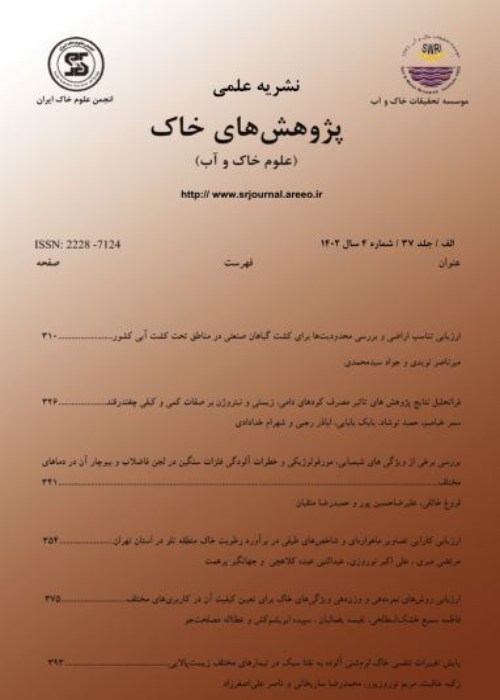Investigation of Changes in Physical and Chemical Properties of Soil during Different Stages of Sugarcane Growth and Estimation of Organic Carbon Sequestration Capacity
Author(s):
Article Type:
Research/Original Article (دارای رتبه معتبر)
Abstract:
The present study was conducted to investigate changes in soil physical and chemical properties and organic carbon storage at different stages of sugarcane growth (Plant, Ratoon 1, Ratoon 2, Ratoon 3, and Ratoon 4) in some sugarcane plantations in southern parts of Khuzestan Province, Iran. For this purpose, a number of soil profiles were dug in the sugarcane fields and 30 sites were selected and studied in a completely randomized design with five treatments (i.e. sugarcane growth stages) and six replications. The results of this study showed that long-term cultivation of sugarcane and different stages of growth in soils of Sugarcane Cultivation and Industry Company caused changes in physicochemical properties and soil carbon storage. Indeed, abundant irrigation and leaching and cultivation management of sugarcane reduced the salinity and sodium in soil solution. Also, different growth stages changed the physical and chemical properties of the soil. Different stages of sugarcane growth reduced electrical conductivity (EC), dissolved sodium in the soil, the available potassium (K), and increased the amount of bulk density (Bd) in the soil. There was no significant difference in the amount of organic matter (OM) and soil acidity (pH) of sugarcane fields at different stages of growth. Finally, in order to prevent possible negative consequences and depletion of soil nutrients, especially potassium, it is necessary to periodically study the complete properties of the soils and evaluate these changes, appropriate management methods can be performed to maintain soil quality. The results showed that difference in soil carbon sequestration was significant (p<5%) in the treatments, such that the highest carbon sequestration was in Raton 3 (28.84 tons/ha) and the lowest in Raton 4 (15.50 tons/ha). The reason for the higher amount of carbon storage can be attributed to more vegetation and, therefore, more plant debris, which reduce evaporation from the soil surface, a positive effect on vegetation, especially in arid and semi-arid regions. In general, optimal management of sugarcane fields plays an important role in improving atmospheric carbon sequestration capacity.
Keywords:
Language:
Persian
Published:
Iranian Journal of Soil Research, Volume:35 Issue: 3, 2022
Pages:
269 to 286
https://magiran.com/p2404377
دانلود و مطالعه متن این مقاله با یکی از روشهای زیر امکان پذیر است:
اشتراک شخصی
با عضویت و پرداخت آنلاین حق اشتراک یکساله به مبلغ 1,390,000ريال میتوانید 70 عنوان مطلب دانلود کنید!
اشتراک سازمانی
به کتابخانه دانشگاه یا محل کار خود پیشنهاد کنید تا اشتراک سازمانی این پایگاه را برای دسترسی نامحدود همه کاربران به متن مطالب تهیه نمایند!
توجه!
- حق عضویت دریافتی صرف حمایت از نشریات عضو و نگهداری، تکمیل و توسعه مگیران میشود.
- پرداخت حق اشتراک و دانلود مقالات اجازه بازنشر آن در سایر رسانههای چاپی و دیجیتال را به کاربر نمیدهد.
In order to view content subscription is required
Personal subscription
Subscribe magiran.com for 70 € euros via PayPal and download 70 articles during a year.
Organization subscription
Please contact us to subscribe your university or library for unlimited access!


